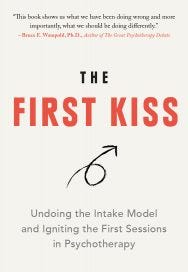Follow the Spark
Updates by Daryl Chow, MA, Ph.D.(Psych)
View this email in your browser
Follow the Spark
By Daryl Chow, MA, PhD on Aug 10, 2018 08:00 am
The paperback of the new book, The First Kiss: Undoing the Intake Model and Igniting First Sessions in Psychotherapy is now available!
The ebook from various retailers (Kindle, Apple, Kobo, etc.) with different reading formats is downloadable here.
SPECIAL: For the first 10 readers, if you like to receive a personalised paperback edition, which includes a one-page dedication to specially to you, drop me an email (info@darylchow.com). All you do is cover the price of the book (USD$18.37), with free shipping!
Here’s a chapter from the book that compliments the previous post, Follow the Pain.
Chapter 25. Follow the Spark
“Find a place inside where there’s joy, and the joy will burn out the pain.”
~ Joseph Campbell, mythologist, writer.
We can’t just follow the pain.
We also need to “follow the spark.”
“What peaks your interest? What do you like doing? What do you do for fun?”
These aren’t ice-breaker questions. They are fire-starters. Figure what your clients enjoy devoting their time and attention to, is quintessential in the first session. Weave your interventions using your client’s sparks. You want their sparks to catch their problems on fire.
I learned this lesson early on when I was doing my post-graduate practicum in a secondary school. The teachers must have mistaken me for a discipline master, as they would send me kids who were acting up. One morning, as soon as I showed up, the school principal came to me and said that she was sending Jonah to see me in the next period—which was in five minutes. Before she left, she said, “By the way, just so that you are prepared, he punched the last counsellor at the family service agency.”
“What? What happened?”
“He said he didn’t like the look on his face.”
I was left with two minutes before the school bell rang for the next period, and I was in panic mode. Before I could start to think clearly, Jonah arrived at the office. He was big for a 15-year-old.
“Hello. I am Daryl.”
“What’s this about?” he asked.
I said, “Wanna go for a drink at the canteen?”
He looked more suspicious.
“I’m paying,” I said. We walked to the canteen.
What ensued changed everything. I said, “I know that I’m a psychologist, and I’m supposed to ask you all these questions about your problems. The truth is, I’m more interested to know what you do for fun. What sort of interests do you have?”
He sized me up and said, “You wouldn’t know anything about it.”
“Try me.”
He said, “I play the sitar.” He paused, waiting for my response.
“That is so cool! Are you serious? I play the sitar too.”
“Yeah right. No way… You’re kidding right?”
The rest is history. In the sessions after, I gravitated towards the use music metaphors (rhythm, harmony, melody) and how these applied to his presenting concerns of impulse control and anger management (“Letting the notes breathe between the notes,” for emotion regulation, “paying attention to others rather than focus on the self,” for fostering prosocial behaviour). In one of our sessions, we cut the talk and had a musical jam! (I’m sure if my practicum supervisor found out, she wouldn’t have approved of it as “evidenced-based practice”).
Of course, not every client will have the same interests as you, though it certainly helps if you have a broad palette for things in life. In the early session, the key is to be able to tap into what the late Klause Grawe calls “resource activation.” He and his colleague Daniel Gassman found that eliciting problems alone did not predict good outcomes. The researchers noted, “Unsuccessful therapists focussed more on the patient’s problems and tended to overlook the patient’s resources.” Instead, the degree of resource activation distinguished successful sessions from the unsuccessful sessions.1
Sometimes, all it takes is to ask, “What’s important for you in your life right now?” Don’t rush your clients for an answer. Tell them you are not looking for the right answer, but one that is real and alive for them. Renowned journalist Cal Fussman who has interviewed several icons like Mikhail Gorbachev, Jimmy Carter, Muhammad Ali, recommends that the best strategy to get to the heart of an interview is to “find out what they love.”2 Remember: EVERYONE wants to tell their story, not just about their symptoms.
A client in his 40s told me “I just want to be there for my people (his family and colleagues).” Even though he was seeing me for the treatment of depressive symptoms, it was clear to me what’s meaningful for him. If I didn’t follow his spark in his life, no matter how hard I fanned the flame for self-care, it wouldn’t ignite the fire. His antidote to his low mood would be to reignite his desire to connect with his wife and kids, and the people he was mentoring at work.
It’s not enough to do cheerleading therapy or just “build on strengths.” Treat “Follow the Pain” as your left foot, and “Follow the Spark” as your right foot. You need both in order to create movement.
Notes:
1 Gassmann, D., & Grawe, K. (2006). General Change Mechanisms: The Relation Between Problem Activation and Resource Activation in Successful and Unsuccessful Therapeutic Interactions. Clinical Psychology & Psychotherapy, 13(1), 1-11. doi:http://dx.doi.org/10.1002/cpp.442
2 Cal Fussman was interviewed a second time on the Tim Ferriss Show. see: https://tim.blog/2016/08/31/cal-fussman-the-master-storyteller-returns/. The segment about best strategies to get to the heart of an interview is at 2:04:12 segment.
The post Follow the Spark appeared first on Frontiers of Psychotherapist Development.
Recent Articles:
Follow The Pain
Avoid TBU (“True But Useless”) Information
Differences in Schools of Psychotherapy, and Why We Need Them.
The 4P’s versus The 1P
The Perils of an Intake Model






